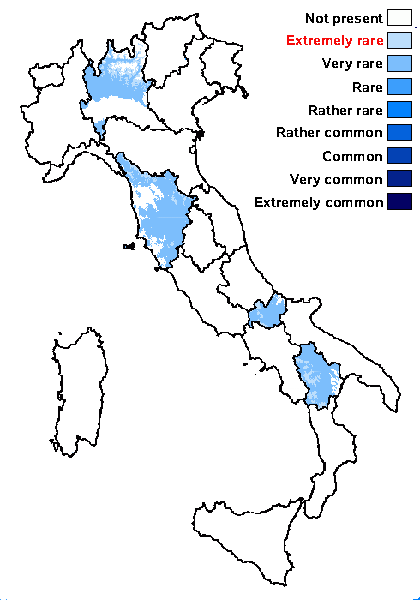Scytinium magnussonii (Degel. & P.M. Jørg.) Otálora, P.M. Jørg. & Wedin
Fungal Divers., 64, 1: 290, 2013. Basionym: Leptogium magnussonii Degel. & P.M. Jørg. in Jørgensen - Lichenologist, 26: 14, 1994.
Synonyms:
Distribution: N - Lomb. C - Tosc (Benesperi 2006), Mol (Paoli & al. 2015). S - Bas (Potenza & al. 2014).
Description: Thallus foliose, dark blue-grey, dark brown to almost black, gelatinous when wet, 2-5 cm wide, the lobes rounded, (1-)2-3 mm wide, 100-125 µm thick, smooth or partially finely striate, with clusters of granulose to coralloid, blackish brown isidia. Lower surface paler blue-grey, naked or with a few whitish hapters. Upper and lower pseudocortex composed of a single layer of angular cells, the layer inbetween of densely intertwined hyphae and loosely arranged chains of Nostoc. Apothecia extremely rare, lecanorine, laminal, shortly pedicellate, with a usually isidiate thalline margin, known only in the immature stage. Thalline exciple pseudocorticate, 25-40 µm wide; proper exciple subparaplectenchymatous, 20-50 µm wide; epithecium brownish; hymenium colourless, 130-150 µm high, I+ blue; paraphyses coherent, c. 2 µm thick at mid-level, the apical cells up to c. 4.5 µm wide; hypothecium colourless, I+ blue. Ascospores not known. Photobiont cyanobacterial (Nostoc, the cells in short chains). Spot tests: all negative. Chemistry: without lichen substances. Note: described from Scandinavia, and also known from western Europe and Austria, this species is found in seepage tracks of granitic rocks, gneiss and weakly calcareous rocks below the subalpine belt. The specimen from Lombardy was collected by U. Gröner (Cannero Municipality, Valle Piancassone, on the road to Travego).
Growth form: Foliose, narrow lobed
Substrata: rocks
Photobiont: cyanobacteria, filamentous (e.g. Nostoc, Scytonema)
Reproductive strategy: mainly asexual, by isidia, or isidia-like structures (e.g. schizidia)
Periodically submerged (e.g. in creeks)
Commonnes-rarity: (info)
Alpine belt: absent
Subalpine belt: absent
Oromediterranean belt: absent
Montane belt: extremely rare
Submediterranean belt: very rare
Padanian area: absent
Humid submediterranean belt: very rare
Humid mediterranean belt: absent
Dry mediterranean belt: absent

Predictive model
Growth form: Foliose, narrow lobed
Substrata: rocks
Photobiont: cyanobacteria, filamentous (e.g. Nostoc, Scytonema)
Reproductive strategy: mainly asexual, by isidia, or isidia-like structures (e.g. schizidia)
Periodically submerged (e.g. in creeks)
Commonnes-rarity: (info)
Alpine belt: absent
Subalpine belt: absent
Oromediterranean belt: absent
Montane belt: extremely rare
Submediterranean belt: very rare
Padanian area: absent
Humid submediterranean belt: very rare
Humid mediterranean belt: absent
Dry mediterranean belt: absent

Predictive model
 INDEX FUNGORUM
INDEX FUNGORUM
 GBIF
GBIF


